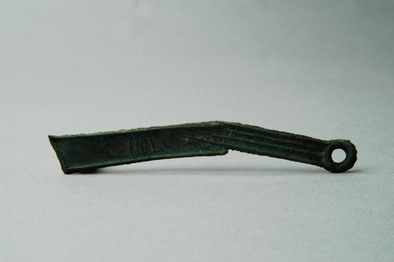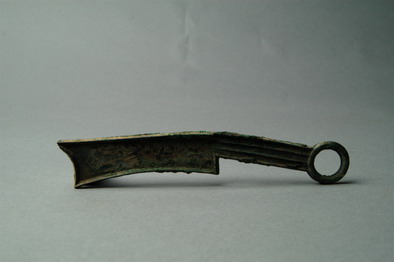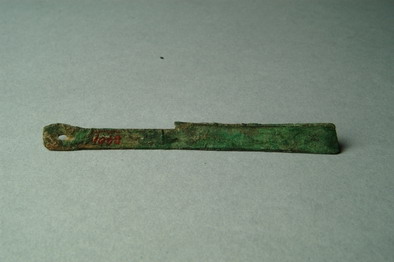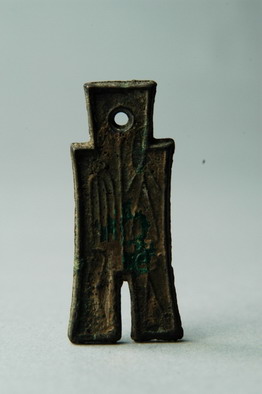The late Western Han Dynasty witnessed the government steeped in paralysis and corruption, rampant land seizures, displaced peasants, skyrocketing grain prices and escalating social conflicts. In 8 AD, the first year of Chushi period, Wang Mang, representative of powerful nobles and landlords, usurped the throne and founded the Xin regime. During the eight years from 7 AD, i.e. the 2nd year of Jushe period,when Wang Mang took power to 14 AD, the first year of Tianfeng period of the Xin Dynasty, Wang Mang reformed currency system four times.
In 7 AD, the second year of Jushe period, Wang Mang carried out the first currency reform after he came into power. Besides the Wu Zhu coin prevalent at the time, he issued three new types of coins by modeling after the pre-Qin coins: “Yi Dao Ping Wu Qian” coin, “Qi Dao Wu Bai” coin and “Da Quan Wu Shi” coin. Because the par value of the new currency was far higher than the production costs, many people turned to counterfeit the coins.
In 9 AD, the first year of Shijianguo period, Wang Mang launched the second currency reform. To break away from the Han Dynasty, “Yi Dao Ping Wu Qian” and “Qi Dao Wu Bai” coins, the two types of high par value, and Wu Zhu coins used in the Western Han Dynasty, were abolished (Dao, or “刀” in Chinese is part of “刘”, the surname of the ruler of the Western Han Dynasty). “Xiao Quan Zhi Yi” coin of low value was issued and circulated with “Da Quan Wu Shi” coin of high value.
In 10 AD, the second year after Wang Mang implemented the system of using the large and small coins, he carried out the third currency reform and adopted Baohuo system of a good variety of coins. Except for some coins of “Qian Huo” of six grades and “Buhuo” of ten grades, other types didn’t circulate at all. Wang Mang was forced to abolish Baohuo system, and only two kinds of coins circulated finally: the small coin that had the same value of a coin and the large coin that had the value of 50 small coins, the same as those used in the first year of Shijianguo period.
In 14 AD, the first year of Tianfeng period of Xin Dynasty, Wang Mang, who particularly liked coins made of gold, silver, tortoise shells and seashells, introduced the fourth currency reform, abolished the large and small coins, cast and issued “Huobu” and “Huoquan” coins.
In most of his currency reforms, Wang Mang acquired enormous wealth by reducing weight of the coins, raising the par value, and even blatant plunder. “Yi Dao Ping Wu Qian” coins circulated for a short time and were rarely seen today, therefore, they are highly valued by the numismatists of all times. According to Dai Xi, a scholar and numismatist in the Qing Dynasty, “Wang Mang ranked first in coin casting; every one has a forte, and Wang’s is coin casting.”
The knife-shaped coin, also known as “Daohua” or “Daohuo” in Chinese, is an ancient currency originating from knife, a production tool. Differentiated in material and shape, they fall into three major categories: knife-shaped coins of Yan State, Qi State, and Zhao State. Here we select some typical ones in the collection of Henan Museum for comparison:
Knife-shaped coin with an inscription of “Ming” , widely used in Yan State (Pic. 1), 1.7 cm long, 17.3 g in weight, in the shape of a knife, has a flat and blunt point and a fairly sharp curve in the blade. On the obverse is a large seal-script character “Ming” in relief. A large number of such coins widely circulated for a long time.

Knife-coins, were predominantly circulated in Qi State, about 17 cm in overall height and 40-55 g in weight. The handle is slightly curved, and the front side bears such inscriptions as “Qi Fa Hua”, “Qi Zhi Fa Hua”, “Anyang Zhi Fa Hua”, “Jie Mo Zhi Fa Hua”, etc.

Straight knife-shaped coins prevalent in Zhao State and Zhongshan State, feature a flat and straight or slightly curved blade and a small size. The obverse bears the name of the place, while the reverse bears some inscription or is plain. For instance, the knife-shaped coin with an inscription of “Bo Ren”, 1.3 cm in length and 8.8 g in weight, has a flat and blunt point, a flat and straight joint between the blade and the handle, and a bulging rim of the front side which bears the large seal-script characters “Bo Ren” in relief. (Pic. 3)

In 7 AD, the second year of Jushe period in the Western Han Dynasty, “Qi Dao Wu Bai” coin (Pic. 4) was made of bronze in the first currency reform when Wang Mang (took power) was regent. It measures 7.42 cm long, 0.35 cm thick, 3.0 cm in diameter, and 16.5 g in weight. The ring looks like a large coin, and has the inner and outer rims. The front side bears two characters “Qi” and “Dao” on the right and left of the rectangular hole, and another two characters “Wu Bai” vertically arranged on the handle.

The comparison indicates that knife-shaped coins of Qi State are usually large and thick, have rims on the front and back sides, and two vertical lines on the handle; those of Qi State bear lively characters and are exquisitely made; those of Yan State are lighter and smaller than those of Qi State, and mostly with the character “Ming”; those of Zhao State feature a small size, flat back and straight blade, and light and thin handle.
“Yi Dao Ping Wu Qian” coin features a unique shape, and has no trace of being constrained by the design of knife-shaped coins during the Spring & Autumn and Warring States periods. In terms of shape, it is the same as “Qi Dao Wu Bai” coin cast in the same period, but they differ a lot regarding the arrangement of characters and the craftsmanship as well as the value. The two gold characters “Yi Dao” inlaid on “Yi Dao Ping Wu Qian” coin make it the only one of the kind in Chinese currency history and the earliest predecessor of coins inlaid with metals. This exquisitely-made coin featuring graceful calligraphy is a piece of artistic treasure. Moreover, few of such coins have been unearthed and passed down, therefore, it takes an important position in Chinese history of coinage.
What measures were taken for coin anti-counterfeiting in ancient times?
Your answer please, if you have any questions or answer, please feel free to send us email, we are waiting for your answers and participation, and your comments, answers and suggestions will be highly appreciated. We will select and publicize the most appropriate answers and comments some time in the future.
Weekly Selection Email: meizhouyipin@chnmus.net
Spade-shaped Coin
Spade-shaped coins, known as “Bubi” or “Chanbi” in Chinese, derived from the spade, a digging tool. In the initial stage, such coins retained the shape of the tool and had a hole for fixing the handle, thus they were called Kongshoubu in Chinese (referring to an eye in the head). Later, their designs were gradually diversified, to be specific, some had a flat head, had no hole, and were slice shaped to facilitate casting and carrying. The flat-head spade-shaped coins usually bear characters, indicating place names such as “Anyi” and “Jinyang”, or units of the coin value such as “Yi Jin(One Jin)” and “Shi Er Zhu(Twelve Zhus)”.
Wang Mang introduced currency reforms and promoted previous systems. During the third reform spade-shaped coins of ten grades were cast:
Xiaobu (1.5 Cun long, 15 Zhu in weight), equaling 100 Wu Zhu coins;
Yaobu (1.6 Cun long, 16 Zhu in weight), equaling 200 Wu Zhu coins;
Youbu (1.7 Cun long, 17 Zhu in weight), equaling 300 Wu Zhu coins;
Houbu (1.8 Cun long, 18 Zhu in weight), equaling 400 Wu Zhu coins;
Chabu (1.9 Cun long, 19 Zhu in weight), equaling 500 Wu Zhu coins;
Zhongbu (2.0 Cun long, 20 Zhu in weight), equaling 600 Wu Zhu coins;
Zhuangbu (2.1 Cun long, 21 Zhu in weight), equaling 700 Wu Zhu coins;
Dibu (2.2 Cun long, 22 Zhu in weight), equaling 800 Wu Zhu coins;
Cibu (2.3 Cun long, 23 Zhu in weight), equaling 900 Wu Zhu coins;
Dabu (2.4 Cun long, 24 Zhu in weight), equaling 1,000 Wu Zhu coins;

The special-shaped “Yi Dao Ping Wu Qian” coin was of high par value and cast during the first currency reform introduced by Wang Mang in 7 AD, the second year of Jushe period in the late Western Han Dynasty. It consists of two parts: a ring and a knife-shaped handle. Shaped like a large coin, the ring has the inner and outer rims, and is inlaid with two gold seal-script characters “Yi” and “Dao”, which are arranged respectively above and below the rectangular hole on the front side, feature an up-down reading order, and are leveled with the surface of the coin. The knife-shaped handle has a rim, is inlaid with three seal-script characters “Ping Wu Qian” in relief, and is plain on the back side. “Ping” literally means “equal”, therefore, a knife-shaped coin equaled 5,000 Wu Zhu coins and two equaled one catty of gold at that time. The five characters feature flowing strokes and look lively, retaining the characteristics of inscription on coins of the Warring States Period.
“Yi Dao Ping Wu Qian” coin was cast in 7 AD, the second year of Jushe period in the Western Han Dynasty, and was abolished in 9 AD when Wang Mang introduced the second currency reform during his reign. Exquisitely made and beautifully shaped, such coins circulated for a short period, and only a small number of them are extant today. Therefore, they provide the best physical evidence for the currency history in the late Western Han Dynasty and are of historical value.

